Impact of Electric Vehicle Charging Synchronization on the Urban Medium Voltage Power Distribution Network of Frederiksberg
Abstract
:1. Introduction
- Providing a large-scale case study based on real data for modelling the PDN and EV demand,
- Making use of novel steady-state SoC and decision-to-charge models to be able to simulate and analyze different charging patterns,
- Providing a novel and straightforward charging allocation methodology to map EV charging events to the PDN,
- Addressing the lack of studies devoted to analyzing the grid impact of charging synchronization which might become more prominent in the future when EV users will follow the same user-centric smart charging objective.
2. Methodology
2.1. Power Distribution Network Modelling
2.2. EV Charging Modelling
2.2.1. Classification of Travel Records
2.2.2. Charging Scenarios and Energy Demand
- () uncontrolled non-daily charging,
- () uncontrolled daily charging,
- () time-synchronized non-daily charging,
- () time-synchronized daily charging, and
- () time-and day-synchronized non-daily charging.
2.2.3. Simulation of Charging Events
2.3. Allocation of Charging Events to the Power Distribution Network
2.4. Power Flow Simulation and Reinforcement Cost Calculation
3. Results
3.1. EV Demand and Aggregated Power Consumption
3.2. Power Distribution Network Impact and Reinforcement Costs
4. Discussion
5. Conclusions
Author Contributions
Funding
Data Availability Statement
Conflicts of Interest
Abbreviations
| CF | Coincidence factor |
| DSO | Distribution system operator |
| EV | Electric vehicle |
| FRB | Frederiksberg |
| PDN | Power distribution network |
| SoC | State-of-charge |
References
- Wolfram, P.; Lutsey, N. Electric Vehicles: Literature Review of Technology Costs and Carbon Emissions; The International Council on Clean Transportation: Washington, DC, USA, 2016; pp. 1–23. [Google Scholar]
- Calearo, L.; Thingvad, A.; Suzuki, K.; Marinelli, M. Grid Loading Due to EV Charging Profiles Based on Pseudo-Real Driving Pattern and User Behavior. IEEE Trans. Transp. Electrif. 2019, 5, 683–694. [Google Scholar] [CrossRef]
- Haider, S.; Schegner, P. Simulating the Impacts of Uncontrolled Electric Vehicle Charging in Low Voltage Grids. Energies 2021, 14, 2330. [Google Scholar] [CrossRef]
- Jones, C.B.; Lave, M.; Vining, W.; Garcia, B.M. Uncontrolled Electric Vehicle Charging Impacts on Distribution Electric Power Systems with Primarily Residential, Commercial or Industrial Loads. Energies 2021, 14, 1688. [Google Scholar] [CrossRef]
- Bitencourt, L.d.A.; Borba, B.S.; Dias, B.H.; Maciel, R.S.; Dias, D.H.; Oliveira, L.W. Electric vehicles charging optimization to improve the insertion considering the Brazilian regulatory framework. Energy Storage 2019, 1, e76. [Google Scholar] [CrossRef]
- Yu, Y.; Shekhar, A.; Mouli, G.C.R.; Bauer, P.; Refa, N.; Bernards, R. Impact of uncontrolled charging with mass deployment of electric vehicles on low voltage distribution networks. In Proceedings of the 2020 IEEE Transportation Electrification Conference & Expo (ITEC), Chicago, IL, USA, 23–26 June 2020; pp. 766–772. [Google Scholar]
- Stiasny, J.; Zufferey, T.; Pareschi, G.; Toffanin, D.; Hug, G.; Boulouchos, K. Sensitivity analysis of electric vehicle impact on low-voltage distribution grids. Electr. Power Syst. Res. 2021, 191, 106696. [Google Scholar] [CrossRef]
- Neaimeh, M.; Wardle, R.; Jenkins, A.M.; Yi, J.; Hill, G.; Lyons, P.F.; Hübner, Y.; Blythe, P.T.; Taylor, P.C. A probabilistic approach to combining smart meter and electric vehicle charging data to investigate distribution network impacts. Appl. Energy 2015, 157, 688–698. [Google Scholar] [CrossRef]
- Procopiou, A.T.; Quirós-Tortós, J.; Ochoa, L.F. HPC-based probabilistic analysis of LV networks with EVs: Impacts and control. IEEE Trans. Smart Grid 2016, 8, 1479–1487. [Google Scholar] [CrossRef]
- Yu, Y.; Reihs, D.; Wagh, S.; Shekhar, A.; Stahleder, D.; Mouli, G.R.C.; Lehfuss, F.; Bauer, P. Data-Driven Study of Low Voltage Distribution Grid Behaviour With Increasing Electric Vehicle Penetration. IEEE Access 2022, 10, 6053–6070. [Google Scholar] [CrossRef]
- Humayd, A.S.B.; Bhattacharya, K. A Novel Framework for Evaluating Maximum PEV Penetration Into Distribution Systems. IEEE Trans. Smart Grid 2018, 9, 2741–2751. [Google Scholar] [CrossRef]
- Boglou, V.; Karavas, C.S.; Arvanitis, K.; Karlis, A. A fuzzy energy management strategy for the coordination of electric vehicle charging in low voltage distribution grids. Energies 2020, 13, 3709. [Google Scholar] [CrossRef]
- Sun, W.; Neumann, F.; Harrison, G.P. Robust Scheduling of Electric Vehicle Charging in LV Distribution Networks Under Uncertainty. IEEE Trans. Ind. Appl. 2020, 56, 5785–5795. [Google Scholar] [CrossRef]
- Veldman, E.; Verzijlbergh, R.A. Distribution grid impacts of smart electric vehicle charging from different perspectives. IEEE Trans. Smart Grid 2014, 6, 333–342. [Google Scholar] [CrossRef]
- Crozier, C.; Morstyn, T.; McCulloch, M. The opportunity for smart charging to mitigate the impact of electric vehicles on transmission and distribution systems. Appl. Energy 2020, 268, 114973. [Google Scholar] [CrossRef]
- IRENA. Electric Vehicle Smart Charging—Innovation Landscape Brief. Technical Report. 2019. Available online: https://irena.org/-/media/Files/IRENA/Agency/Publication/2019/Sep/IRENA_EV_smart_charging_2019.pdf?la=en&hash=E77FAB7422226D29931E8469698C709EFC13EDB2 (accessed on 15 September 2022).
- Bollerslev, J.; Andersen, P.B.; Jensen, T.V.; Marinelli, M.; Thingvad, A.; Calearo, L.; Weckesser, T. Coincidence Factors for Domestic EV Charging From Driving and Plug-In Behavior. IEEE Trans. Transp. Electrif. 2022, 8, 808–819. [Google Scholar] [CrossRef]
- Gonzalez Venegas, F.; Petit, M.; Perez, Y. Plug-in behavior of electric vehicles users: Insights from a large-scale trial and impacts for grid integration studies. eTransportation 2021, 10, 100131. [Google Scholar] [CrossRef]
- Verzijlbergh, R.A.; De Vries, L.J.; Lukszo, Z. Renewable energy sources and responsive demand. Do we need congestion management in the distribution grid? IEEE Trans. Power Syst. 2014, 29, 2119–2128. [Google Scholar] [CrossRef]
- Jones, C.B.; Vining, W.; Lave, M.; Haines, T.; Neuman, C.; Bennett, J.; Scoffield, D.R. Impact of Electric Vehicle customer response to Time-of-Use rates on distribution power grids. Energy Rep. 2022, 8, 8225–8235. [Google Scholar] [CrossRef]
- Sayed, M.A.; Atallah, R.; Assi, C.; Debbabi, M. Electric vehicle attack impact on power grid operation. Int. J. Electr. Power Energy Syst. 2022, 137, 107784. [Google Scholar] [CrossRef]
- Soykan, E.U.; Bagriyanik, M.; Soykan, G. Disrupting the power grid via EV charging: The impact of the SMS Phishing attacks. Sustain. Energy, Grids Netw. 2021, 26, 100477. [Google Scholar] [CrossRef]
- Monta ApS. Skær Ned på Din Elregning og CO2 Udslip. Available online: https://monta.com/dk/hjemmeladning/ (accessed on 16 September 2022).
- True Energy. Smart Charge with True Energy. Available online: https://www.trueenergy.io/ev-charging/ (accessed on 16 September 2022).
- Radius. De Højere Elpriser Medfører ÆNdringer i Nettariffen. Available online: https://radiuselnet.dk/elnetkunder/tariffer-og-netabonnement/prisaendringer/#:~:text=P%C3%A5%20grund%20af%20de%20h%C3%B8je,skemaet%20l%C3%A6ngere%20nede%20p%C3%A5%20siden (accessed on 16 September 2022).
- GEOTAB Energy. Charge the North: Phase Two—Charging Infrastructure with Dynamic and Distributed Price Signals for Load Shaping—Final Report. Technical Report. 2021. Available online: https://5vtj648dfk323byvjb7k1e9w-wpengine.netdna-ssl.com/wp-content/uploads/2021/07/geotab-charge-the-north-report-2-2021-DS03521.pdf (accessed on 15 September 2022).
- Alexeenko, P.; Bitar, E. Achieving Reliable Coordination of Residential Plug-in Electric Vehicle Charging: A Pilot Study. arXiv 2021, arXiv:2112.04559. [Google Scholar]
- van Bokhoven, P.; Gardien, L.; Klapwijk, P.; Refa, N.; Berende, M.; van Zante, A.; Heinen, J.W.; Kats, R. Charge Management of Electric Vehicles at Home—Testing Smart Charging with a Home Energy Management System. Technical Report. 2020. Available online: https://elaad.nl/wp-content/uploads/2022/08/rapport_charge-management-of-electric-vehicles-at-home.pdf (accessed on 14 September 2022).
- Esther Dudek, K.; Platt, N.S. Electric Nation Customer Trial Final Report. Technical Report. 2019. Available online: https://eatechnology.com/media/girhcnsc/electric-nation-customer-trial-report.pdf (accessed on 14 September 2022).
- Kröger, D.; Rauma, K.; Spina, A.; Rehtanz, C. Scheduled charging of electric vehicles and the increase of hosting capacity by a stationary energy storage. In Proceedings of the 25th International Conference on Electricity Distribution (CIRED 2019), Madrid, Spain, 3–6 June 2019. [Google Scholar]
- Mahat, P.; Handl, M.; Kanstrup, K.R.; Lozano, A.P.; Sleimovits, A. Price based electric vehicle charging. In Proceedings of the 2012 IEEE Power and Energy Society General Meeting, San Diego, CA, USA, 22–26 July 2012; pp. 1–8. [Google Scholar]
- Sadeghianpourhamami, N.; Refa, N.; Strobbe, M.; Develder, C. Quantitive analysis of electric vehicle flexibility: A data-driven approach. Int. J. Electr. Power Energy Syst. 2018, 95, 451–462. [Google Scholar] [CrossRef] [Green Version]
- FUSE—Frederiksberg Urban Smart Electromobility. Available online: http://www.fuse-project.dk (accessed on 31 March 2022).
- Unterluggauer, T.; Rich, J.; Andersen, P.B.; Hashemi, S. Electric vehicle charging infrastructure planning for integrated transportation and power distribution networks: A review. eTransportation 2022, 12, 100163. [Google Scholar] [CrossRef]
- Hipolito, F.; Vandet, C.; Rich, J. Charging, steady-state SoC and energy storage distributions for EV fleets. Appl. Energy 2022, 317, 119065. [Google Scholar] [CrossRef]
- Baescu, O.; Christiansen, H. The Danish National Travel Survey Annual Statistical Report TU0619v2; Technical Report; DTU Management: Copenhagen, Denmark, 2020. [Google Scholar]
- Danmarks Statistik. BIL54: Bestand af Motorkøretøjer Efter Brugerforhold, Køretøjstype, Område, Drivmiddel og tid. Available online: https://www.statbank.dk/statbank5a/SelectVarVal/Define.asp?MainTable=BIL54&PLanguage=0&PXSId=0&wsid=cftree (accessed on 31 March 2022).
- Danmarks Statistik. BIL707: Bestanden af Køretøjer pr 1 Januar Efter Område og Køretøjstype. Available online: https://www.statistikbanken.dk/bil707 (accessed on 31 March 2022).
- Klyapovskiy, S.; You, S.; Michiorri, A.; Kariniotakis, G.; Bindner, H.W. Incorporating flexibility options into distribution grid reinforcement planning: A techno-economic framework approach. Appl. Energy 2019, 254, 113662. [Google Scholar] [CrossRef]
- Klyapovskiy, S.; You, S.; Cai, H.; Bindner, H.W. Incorporate flexibility in distribution grid planning through a framework solution. Int. J. Electr. Power Energy Syst. 2019, 111, 66–78. [Google Scholar] [CrossRef]
- Finansministeriet. Grøn Skattereform Aftale om Grøn Skattereform; Technical Report; Finansministeriet: Copenhagen, Denmark, 2020.
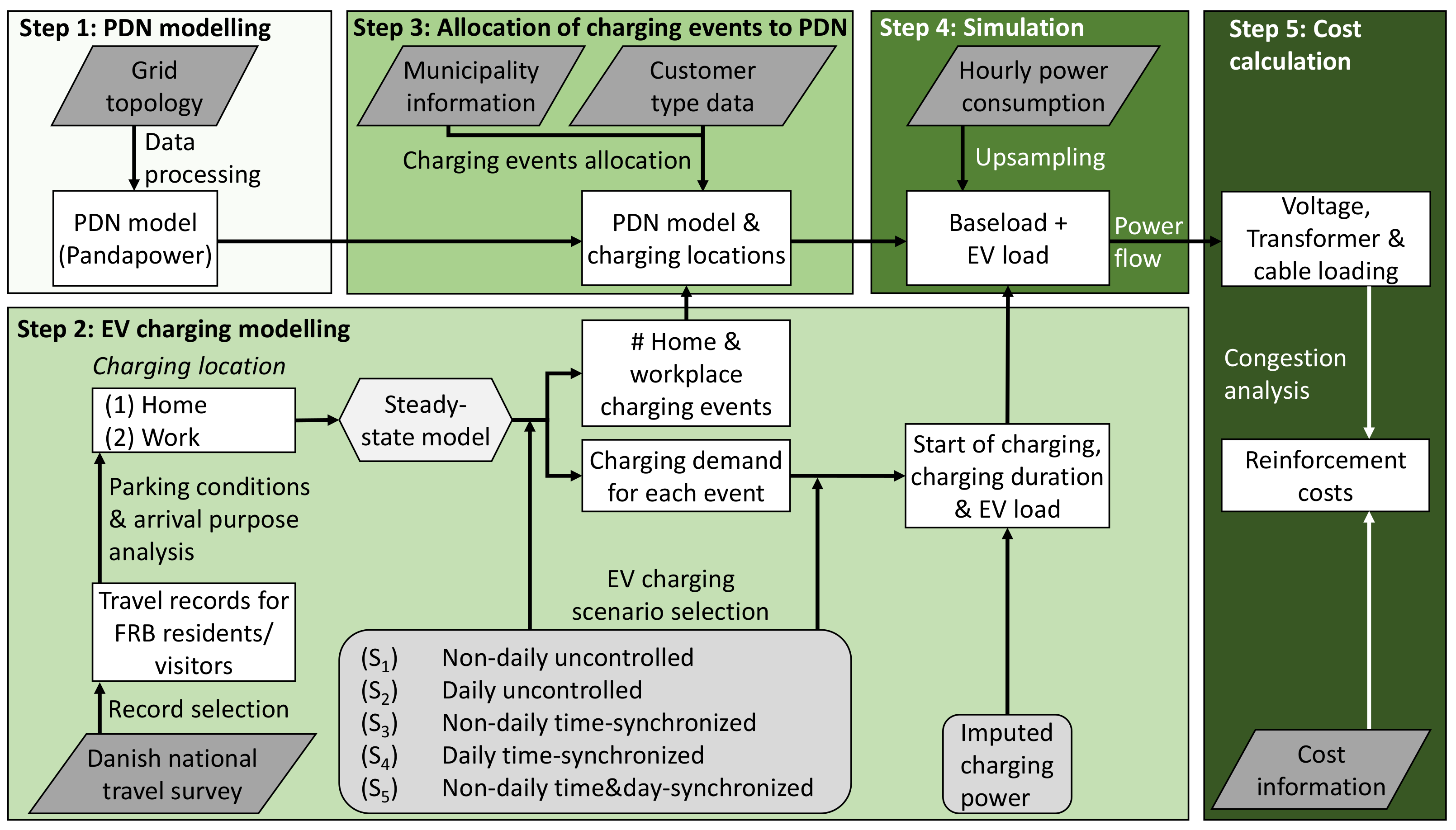
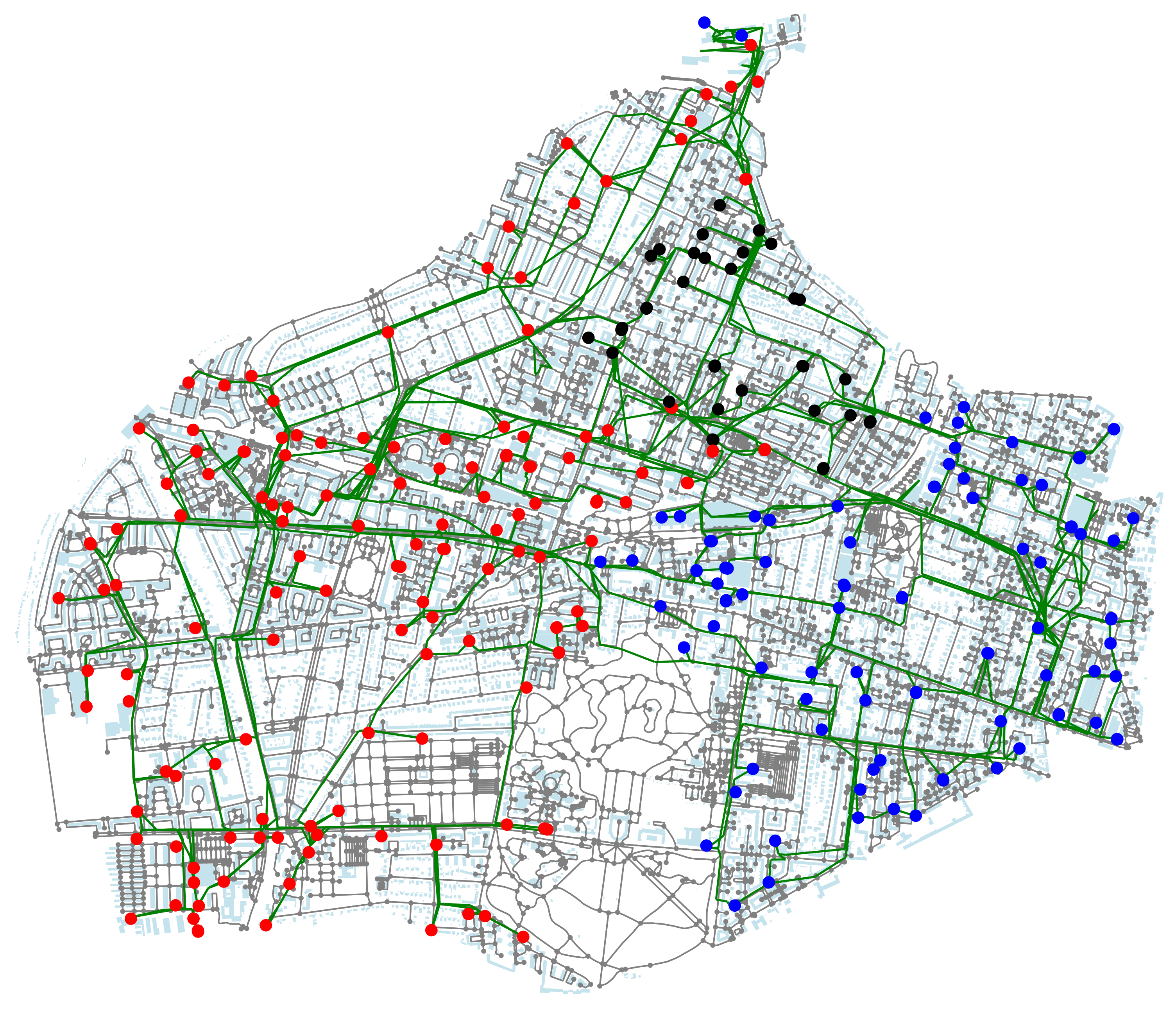
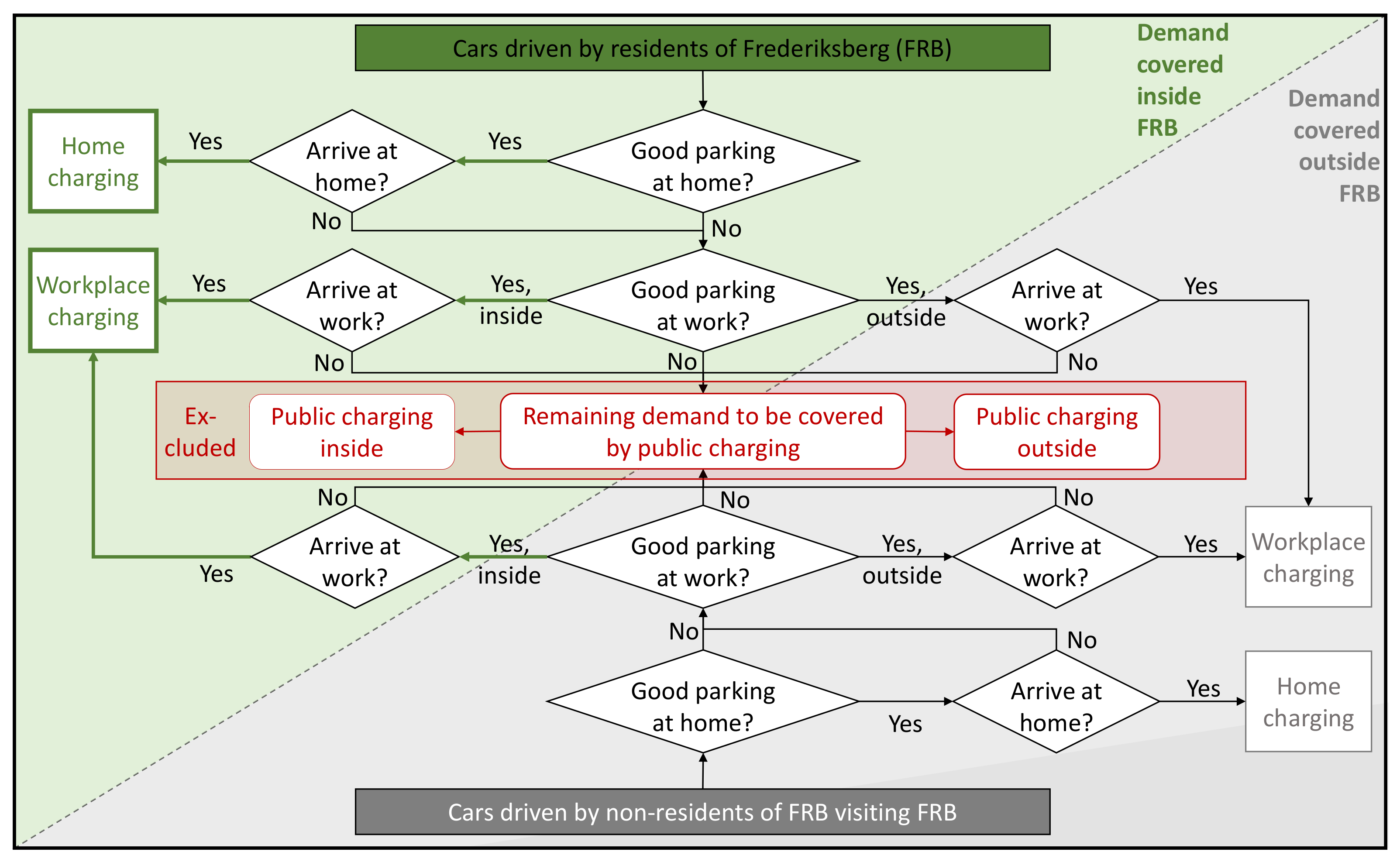
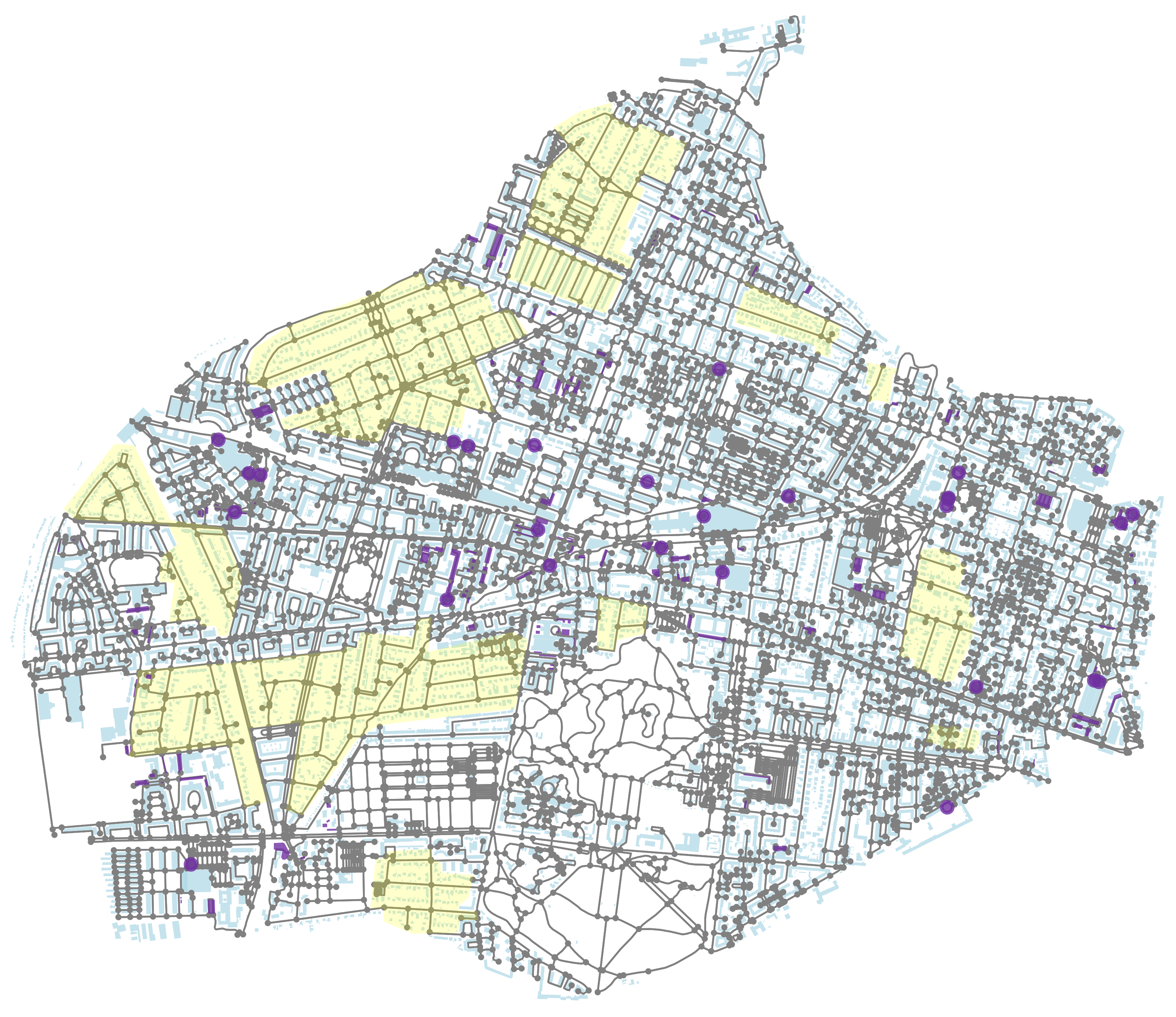
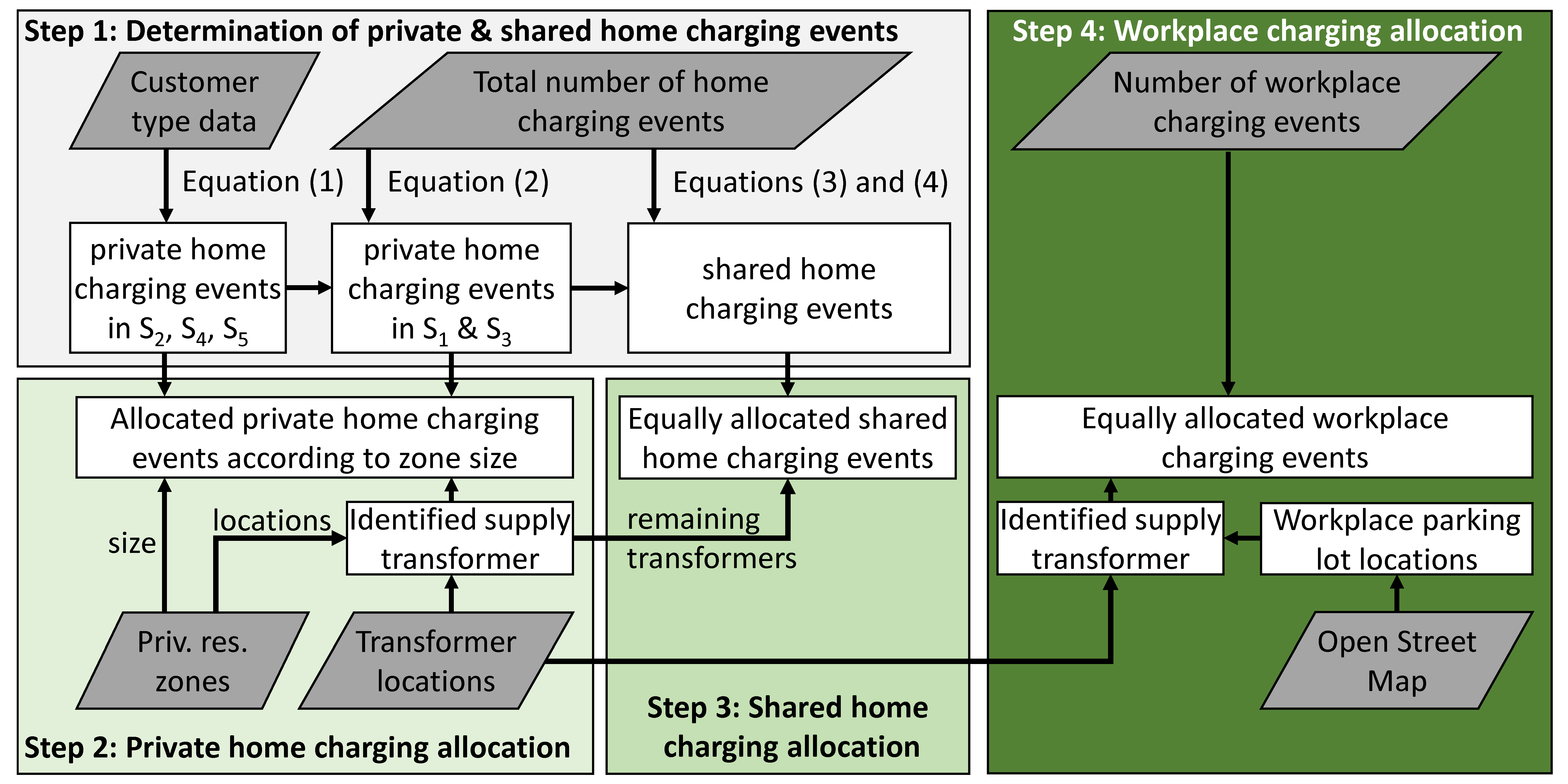
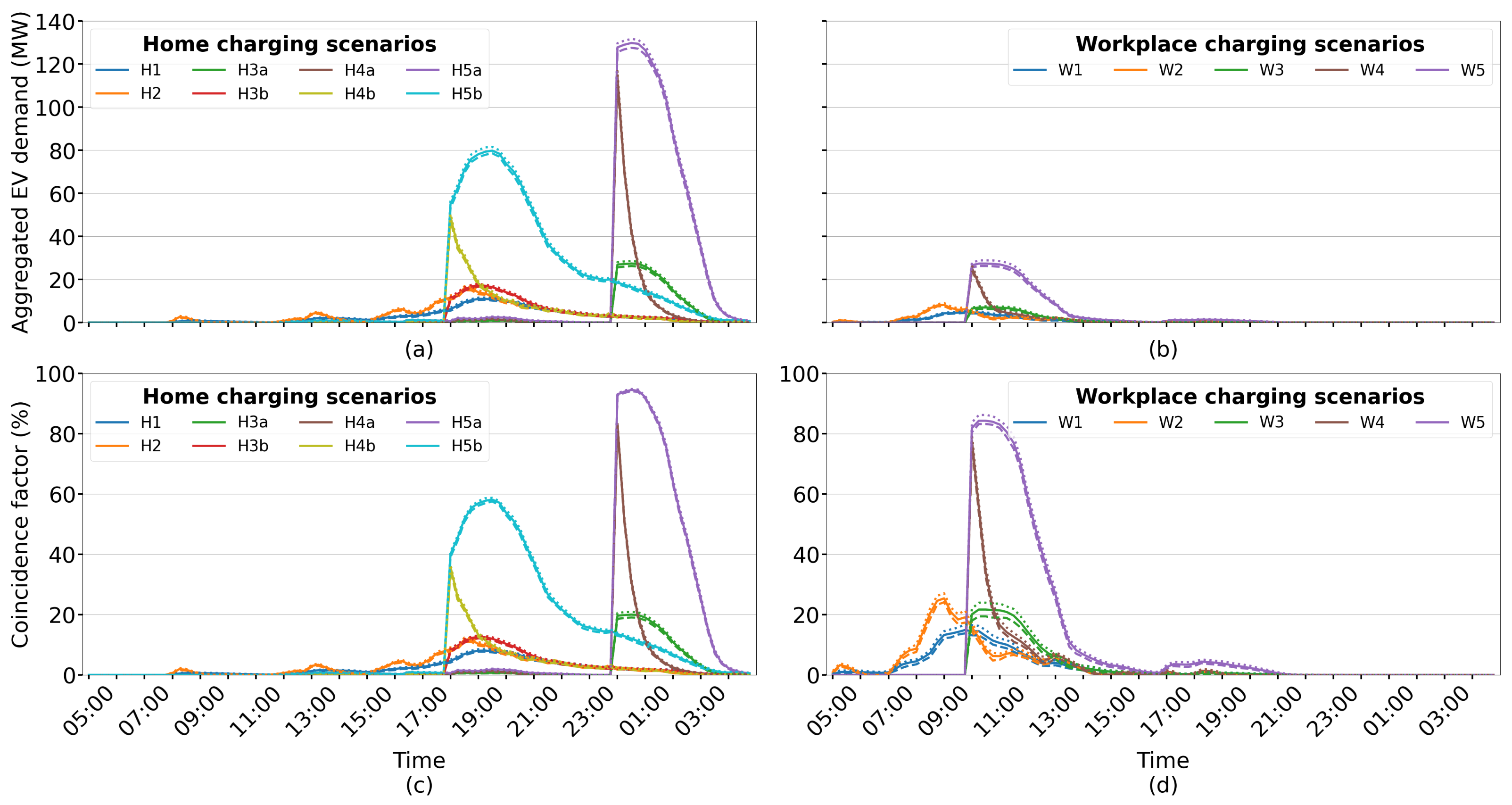

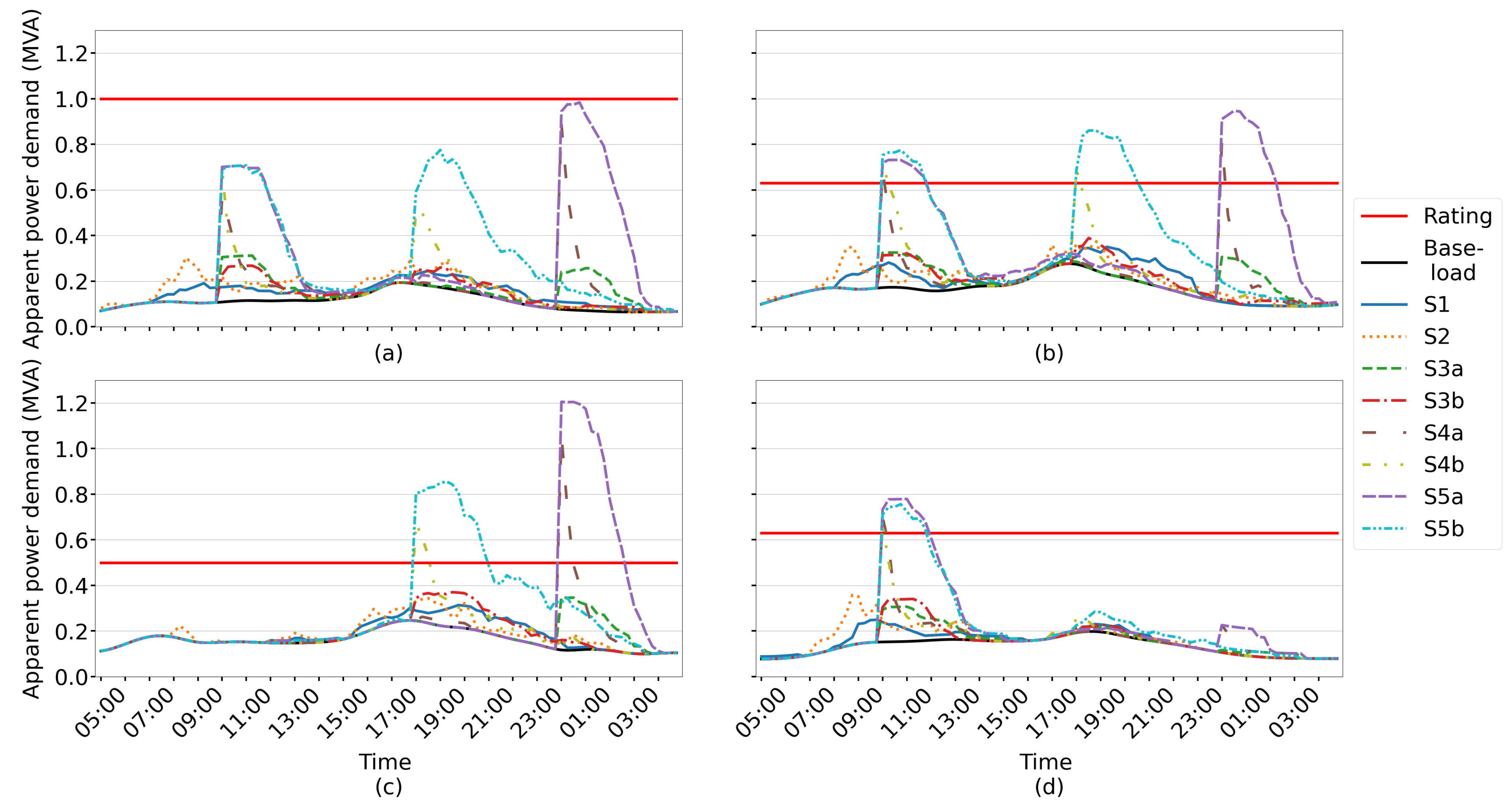
| FRBi | (km) | ||
|---|---|---|---|
| 1 | 152 | 222 | 93.4 |
| 2 | 98 | 157 | 60.0 |
| 3 | 34 | 61 | 19.9 |
| 2793 | 12,686 | 2793 | 12,686 | 12,686 | |
| 867 | 3089 | 867 | 3089 | 3089 | |
| 68.4 | 81.2 | 68.4 | 81.2 | 350.5 | |
| 21.2 | 26.1 | 21.2 | 26.1 | 83.4 |
| pattern | n.d. | daily | n.d. | n.d. | daily | daily | n.d. | n.d. |
| control | none | none | T.S. | T.S. | T.S. | T.S. | T.D.S. | T.D.S. |
| none | none | 24:00 | 18:00 | 24:00 | 18:00 | 24:00 | 18:00 | |
| none | none | 10:00 | 10:00 | 10:00 | 10:00 | 10:00 | 10:00 |
| , – | 275 | 1312 | 480 | 21 | 821 | 313 | 11 | 353 | 74 |
| , – | 1244 | 5953 | 1710 | 95 | 3734 | 1116 | 54 | 1606 | 263 |
| (MW) | (%) | ||
|---|---|---|---|
| 11.6 | 19:15 | 8.5 | |
| 16.9 | 18:30 | 12.4 | |
| 28.6 | 00:30 | 21.0 | |
| 18.0 | 19:00 | 13.1 | |
| 116.8 | 24:00 | 83.7 | |
| 50.4 | 18:00 | 36.5 | |
| 131.7 | 00:30 | 94.8 | |
| 81.6 | 19:30 | 58.7 | |
| 5.3 | 10:00 | 16.8 | |
| 9.1 | 09:00 | 27.0 | |
| 7.6 | 10:15 | 23.9 | |
| 26.6 | 10:00 | 79.8 | |
| 28.9 | 10:15 | 86.2 |
| (km) | (k€) | |||||||
|---|---|---|---|---|---|---|---|---|
| Load (%) | >75 | >100 | >75 | >100 | >75 | >100 | >75 | >100 |
| 5, 1, 0 | 1, 0, 0 | 0, 0, 0 | 0, 0, 0 | 0, 0, 0 | 0, 0, 0 | 130 | 22 | |
| 12, 7, 0 | 1, 1, 0 | 0, 0, 0 | 0, 0, 0 | 0, 0, 0 | 0, 0, 0 | 411 | 43 | |
| 6, 2, 0 | 1, 0, 0 | 0, 0, 0 | 0, 0, 0 | 0, 0, 0 | 0, 0, 0 | 173 | 22 | |
| 7, 2, 0 | 1, 0, 0 | 0, 0, 0 | 0, 0, 0 | 0, 0, 0 | 0, 0, 0 | 195 | 22 | |
| 120, 69, 32 | 59, 40, 9 | 32, 9, 0 | 16, 3, 0 | 16.5, 5.3, 0 | 8, 2.1, 0 | 7676 | 3680 | |
| 74, 52, 14 | 34, 21, 4 | 12, 2, 0 | 2, 0, 0 | 5.1, 1.3, 0 | 0.4, 0, 0 | 3878 | 1333 | |
| 122, 69, 32 | 86, 67, 25 | 34, 13, 0 | 19, 4, 0 | 17.6, 7.1, 0 | 9.2, 3.3, 0 | 8103 | 5509 | |
| 112, 69, 32 | 54, 38, 8 | 21, 9, 0 | 11, 2, 0 | 10.1, 5.3, 0 | 4.9, 1.3, 0 | 6656 | 2983 |
Publisher’s Note: MDPI stays neutral with regard to jurisdictional claims in published maps and institutional affiliations. |
© 2022 by the authors. Licensee MDPI, Basel, Switzerland. This article is an open access article distributed under the terms and conditions of the Creative Commons Attribution (CC BY) license (https://creativecommons.org/licenses/by/4.0/).
Share and Cite
Unterluggauer, T.; Hipolito, F.; Klyapovskiy, S.; Andersen, P.B. Impact of Electric Vehicle Charging Synchronization on the Urban Medium Voltage Power Distribution Network of Frederiksberg. World Electr. Veh. J. 2022, 13, 182. https://doi.org/10.3390/wevj13100182
Unterluggauer T, Hipolito F, Klyapovskiy S, Andersen PB. Impact of Electric Vehicle Charging Synchronization on the Urban Medium Voltage Power Distribution Network of Frederiksberg. World Electric Vehicle Journal. 2022; 13(10):182. https://doi.org/10.3390/wevj13100182
Chicago/Turabian StyleUnterluggauer, Tim, F. Hipolito, Sergey Klyapovskiy, and Peter Bach Andersen. 2022. "Impact of Electric Vehicle Charging Synchronization on the Urban Medium Voltage Power Distribution Network of Frederiksberg" World Electric Vehicle Journal 13, no. 10: 182. https://doi.org/10.3390/wevj13100182
APA StyleUnterluggauer, T., Hipolito, F., Klyapovskiy, S., & Andersen, P. B. (2022). Impact of Electric Vehicle Charging Synchronization on the Urban Medium Voltage Power Distribution Network of Frederiksberg. World Electric Vehicle Journal, 13(10), 182. https://doi.org/10.3390/wevj13100182






